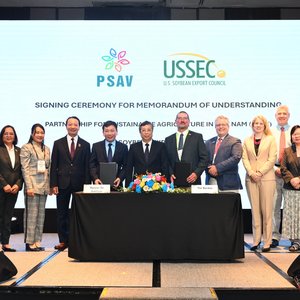Lucta, a global expert in palatability solutions for animal feeds and food aromas, has registered for the F3 Krill Replacement Challenge with a customized product that combines a sensory additive from Lucta, acting as a functional palatability enhancer, with the superior nutritional qualities of Uniprotein®, a single-cell protein ingredient produced by Unibio from the fermentation of Methylococcus capsulatus.
The combined product consists of a source of protein with an amino acid profile resembling that of fishmeal, a favorable mineral content, and good digestibility, supplemented with substances that act as potent feeding cues by signaling the presence of good quality protein in the feed, and also including specific free amino acids and small peptides acting as functional supplements by activating gastrointestinal function.
“We are aware that krill meal, just like fishmeal, is an ingredient with outstanding and complex properties, from palatability to nutritional and even functional qualities, and therefore, difficult to replace using a single ingredient or supplement. Therefore, we need to think innovatively and look for holistic solutions that combine ingredients and additives in synergistic or at least complementary ways,” Sofia Morais, Innovation AQUA team leader at Lucta, explained.
Lucta’s sensory additives
Lucta has been developing innovative sensory strategies to modulate feeding behavior and solve feed intake (feed acceptability) issues in farmed animal species for over 30 years. The company’s sensory additives are composed of substances and ingredients from both synthetic and natural sources of non-animal origin. “This aspect is noteworthy because many animal tissues can naturally have high variations in their composition, which is influenced by their diets and seasonal fluctuations (related to maturity stage, status of energetic reserves, etc.), and therefore can be more difficult to standardize,” Morais explained.
The products are based on flavoring compositions strongly rooted in scientific knowledge of the different species’ sensory biology, organoleptic preferences, and animal feeding behavior. Some of the soluble components of fishmeal that activate the trout’s sensory and gut-brain communication systems have been studied as part of Lucta’s collaborative projects, while other academic groups have published information on attractive tastants and odorants commonly present in marine ingredients, including fish and krill meal. Lucta has applied this knowledge in the development of sensory additives for aquaculture species, including the pioneering concept (in fish, but already successfully applied in the swine industry for many years) of the use of umami taste-stimulating substances on gastrointestinal amino acid sensing and feed intake regulation in fish species such as gilthead seabream and trout.
“Lucta’s strategy is to develop functional palatability enhancers as a blend of chemosensory active substances, which can be naturally found in preferred and highly palatable marine ingredients. Animals, including fish, have strong innate food selection mechanisms relying on chemical signals to detect and orient towards a food source and to evaluate that it is adequately nutritious (i.e., meeting its requirements) and free of potentially hazardous or toxic substances. Animals have evolved with substances present in their natural habitats and, therefore, might not recognize or make voluntary feeding choices of certain unfamiliar ingredients, even when they are a good source of nutrients,” Morais explained.
“When supplemented in feeds, these familiar substances, included in Lucta’s sensory additives, enhance sensory cues of attractive smell and taste, triggering fish appetite. On the other hand, it is also known that certain soluble components that are quickly released from the food (ahead of digestion and absorption) can activate receptors, including taste receptors along the gastrointestinal tract, generating neuronal stimuli and the release of hormonal signals that are involved in the regulation of satiety, digestive and absorptive processes, as part of the gut-brain axis. This fact can partly explain why certain ingredients, such as fish and krill meal, have good palatability and the potential to improve feeding efficiency. Lucta’s functional palatability enhancers can stimulate these mechanisms when supplemented into feeds, especially when using ingredients poor in such active substances,” Morais stated.
Performance in aquafeeds
Lucta’s concept and similar functional palatability enhancer products have been successfully tested in different fish species globally, including gilthead seabream, European seabass, rainbow trout, Atlantic salmon, Asian seabass, snakehead fish, yellow catfish, largemouth bass, large yellow croaker, and tilapia.
“Results reported so far with this type of additives have been improvements in feed intake, growth performance, and a reduction in FCR. However, the magnitude of the effect can be variable and depends on the nature of the species (some being more “picky” than others), on environmental conditions (with more significant results when animals are outside of their physiological optimum), if the trial is performed under undisturbed or stressed conditions, whether there are feeding deterrents (i.e., aversive substances) present in the diet, or on the overall palatability level of the feed,” Morais explained.
“We have extensively tested these products in feeds with significantly reduced levels of fishmeal and other marine ingredients, at levels found to affect feed acceptability, especially in some more demanding species. As a general rule, we observed that the higher the level of fishmeal reduction, the higher the feed intake reduction and the potential to improve it using Lucta’s palatability enhancers, but this also greatly depends on the ingredients used for substitution. The F3 Challenge will provide us with an excellent opportunity to test our additive in a more extreme situation,” Morais said.
“The product for the F3 challenge is a customized and combined product developed in partnership with Unibio, which will be the first time that it will be tested jointly, and we believe will meet the nutritional, functional, and palatability characteristics required to replace krill meal in aquafeeds successfully,” Morais said.
Lucta’s sensory additives are used at a low inclusion level and, therefore, at a fraction of the cost of an alternative ingredient, Morais said. “For the same reason, they cannot be considered a significant source of nutrients; even if it does contain some nutrients, they are at a level that will mostly ‘signal’ processes that will result in a higher feed intake and/or in an improved gut function leading to better utilization of the nutrients in the alternative ingredients. Therefore, the cost-effectiveness will also greatly depend on the alternative protein source used.”
Regarding supply, the synthetic and natural compounds used in the additive’s formulation are widely available, so no constraints are expected.
“We believe krill is a very ‘complete’ ingredient, but certainly not sustainably available at the levels the growing industry will need it, and raising important ethical concerns on the potential ecological impacts in ocean food webs. Therefore, we undoubtedly need alternatives, and we expect that the F3 Krill Replacement Challenge will show us that krill replacement can be achieved. Also, and probably equally significant, we need more new, safe, mass-produced, nutritious and sustainable ingredients to address this and other current challenges and support the aquaculture industry’s growth under good sustainability and welfare standards,” Morais stated.
“An important outcome of the F3 Challenge should be to allow showcasing some of the novel and emerging products and technologies but also foster collaboration and innovative solutions. In this respect, in Lucta, we strongly believe that single-cell proteins such as Uniprotein® have the potential to become a key ingredient in the aquafeed raw material basket and that sensory additives should be part of the holistic solution to improve the attractability and performance of future aquafeeds using novel ingredients,” Morais concluded.
Aquafeed.com has been interviewing some registrants of the F3 Krill Replacement Challenge. See below.
Entobel: The attraction of insect meal
eniferBio: The power of mycoprotein
JF Nutritech: Could phytonutrients replace krill?
Stratium: Insect protein to replace krill
Symrise Aqua Feed: Land-based byproducts
Protenga: An insect-based palatability enhancer
Nutrition Technologies: A new insect-based approach
Shaivaa Algaetech: A mix of microalgae
Palmatech Product: A palm oil concentrate
dsm-firmenich: A palatable protein ingredient
BCF Life Science: A functional amino acid concept
China-based Jiangsu Fuhai Biotech Co., Ltd.: A soybean peptide










